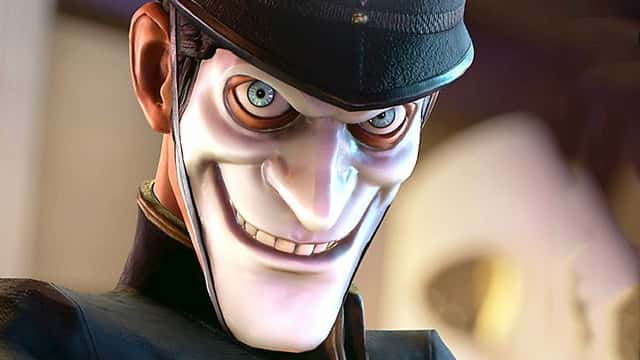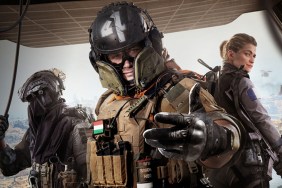We Happy Few is a game with a curious development history. Compulsion Games initially looked to crowdfund the title with the aim of creating a roguelike survival game set within a dystopian alternative history England, where the Germans had successfully managed to invade the country during World War II. Despite this dreary setting, concept art showed vibrant landscapes and surprisingly happy characters who were drugged up on “Joy,” a sort of antidepressant/roofie combo that helped post-war Brits cope and forget the past.
Thanks to the 7,433 backers, the goal of CA$250,000 was achieved and the game was ready to start being made. Compulsion was determined to keep its backers looped in with playable alpha builds, and welcomed feedback from the community. The team of seven original developers were clearly keen to please their thousands of supporters, and were willing to change major elements of gameplay to keep those players happy. It was an indie game doing what it does best: listening to players without needing to consider the bigwigs upstairs and shareholders leering down.

Then the unconventional happened, with We Happy Few being scouted by Gearbox Publishing (Hello Neighbor, Subnautica, Fortnite). Following several big marketing pushes, where the game was thrust into the spotlight during major gaming events, the buzz surrounding the title grew considerably. Gamers were especially interested in the art style and wacky characters, and this factored heavily into We Happy Few‘s new focus on narrative. Now wanting to tell a bigger story by fleshing out several characters, Compulsion expanded its team to 40 and set its sights on evolving the 3-4 hour roguelike experience into a full-fledged, 20-hour adventure.
More content meant more costs, which ultimately led to the game being priced at $60 (or $80 with the season pass). Now boasting a full price, it’s understandable why gamers might expect more of We Happy Few. Has the little indie game from three years ago done enough to contend?
We Happy Few Review – Dystopia Has Never Looked This Good
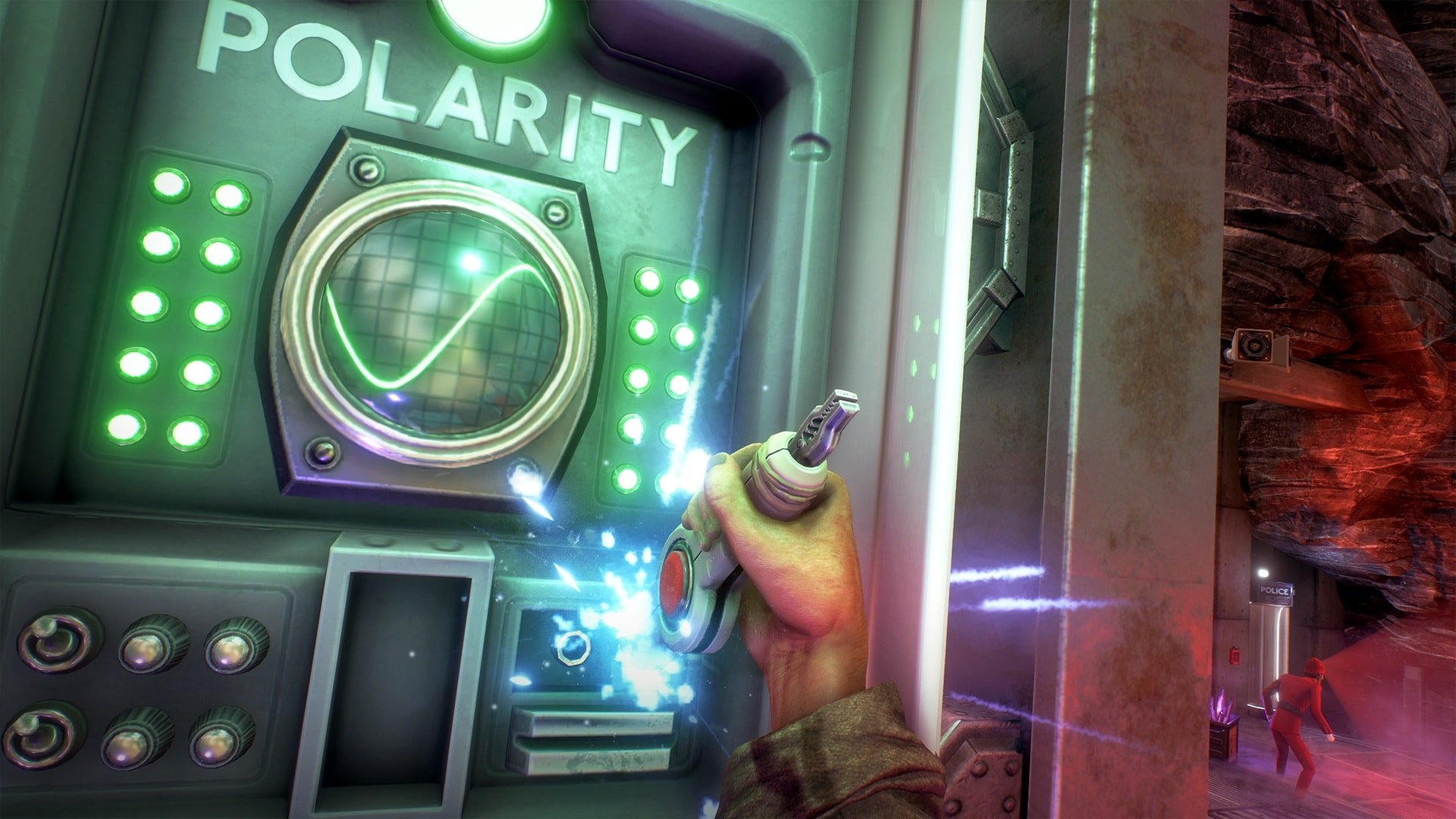
After being occupied by Germany during World War II, England is looking a little worse for wear. Thankfully, the war-torn landscapes are quickly remedied with Joy, the drug that all citizens are required to take. Start seeing crashed fighter planes and bombed-out buildings? Begin to wonder where all the children have disappeared to? No need to worry, just pop a joy and those horrifying scenes will be replaced with rainbows and butterflies!
We Happy Few offers a unique look at a defeated England that has been forced to conform. The familiar Unreal Engine 4 works brilliantly well to render a surprisingly detailed world, which impresses at all hours during the day/night cycle. Both rural landscapes and bustling cities look brilliant, even after you’ve stopped popping the saturation overloading Joy pills. Performance on PC left a lot to be desired, however, but I’m hoping further optimizations for launch will solve this. (Ultra settings at 1080p proved playable on my 1700/1070 rig, but drops to 25fps were a tad annoying. GPU usage was limited to 50% in many areas, which was no doubt causing this issue.)
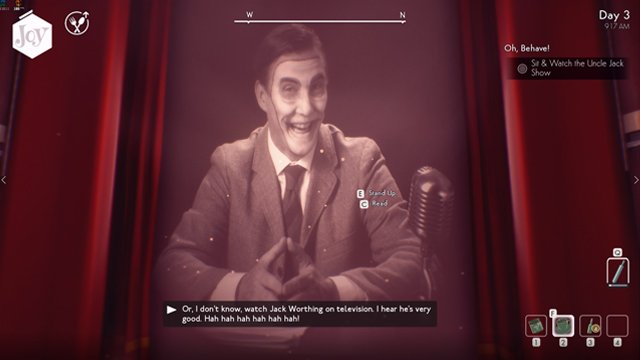
The fictional southwestern Wellington Wells is populated with many memorable faces, including the playable Arthur, Sally, and Ollie — all of whom are dealing with their own personal tragedies, which take players down different story arcs — as well as the sinister policemen, referred to as “Bobbies,” and equally creepy “Doctors.” Then there’s Uncle Jack, a too-happy TV host that pops up now and then to remind folks to take their Joy. (Uncle Jack also features in a free VR game, if that’s your cup of tea.) The great voice acting really helps here, and is one of the many highlights of overall solid sound design. The remaining populace is mostly made up of copied and pasted NPC models that don’t boast much in the way of personality. Thankfully, the various discoverable diary entries and documents do offer a bit context and add to the lore. If you don’t mind reading in your video games, you’ll find them enjoyable.
Also worthy of mention is the game’s procedurally generated elements. The layouts of streets are randomly generated, with each player experiencing something different. My labyrinth of avenues and alleyways proved especially unlucky, forcing me to traverse a particularly lengthy route around the outskirts of the map to avoid detection. In the story mode, I don’t think this feature is particularly effective, and I much prefer the handcrafted portions. However, once the Sandbox mode launches, I’m sure the procedural generation will come in useful.
We Happy Few Review – 20 Hours… and Then Some!
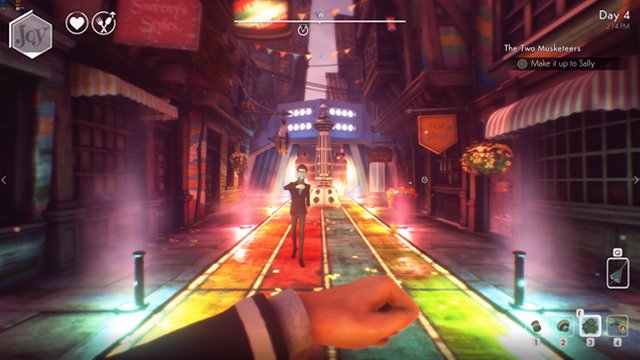
As touched on earlier, players are put into the shoes of three different playable characters. Arthur is your first vessel, followed by Sally, and finally Ollie. These characters have their own unique stories, which are interwoven as they meet each other. Unfortunately, Arthur was a bit of a drag to play as, while Sally proved much more interesting to me. Ollie is just plain bonkers, shouting out insults if he doesn’t get his glucose shots, making for a fun third act. The problem here is that Arthur the Unbearable’s playthrough took me 14 hours, with a decent bit of open world exploration and side missions completed. You then move on to Sally, heading to areas that you previously visited as Arthur. Then it’s Ollie’s turn. The bright side here is that Compulsion Games’ promise of a 20-hour story mode is certainly fulfilled, with the generous number of main and side missions pushing 100% completion to beyond 30 hours. Sadly, there’s an awful lot of timewasting that, if I’m being cynical, makes me feel that the devs were really pushing to make sure this game was a long one. The need to walk (don’t run!) long distances, when fast travel points aren’t yet available, is especially excruciating.
The hunger and thirst mechanics showcased in early previews managed to dodge the cut, surviving the change from roguelike survival to story-focused adventure. However, they have been toned down to cause stat debuffs, as opposed to outright killing the character. Players will need to be conscious of sleeping and avoid overdosing on Joy. It might sound like a lot to manage, but at least on normal difficulty, I rarely had to think about it. Custom difficulty modes are supported, however, so you can tweak certain elements to make your experience easier or more challenging.
Helping gameplay to feel somewhat fresh is the skill tree system. All three characters have their own separate trees, though many of the abilities overlap. Skill trees allow for buffs in the stealth and combat categories, as well as other boosts, like increased inventory space. The skills won’t blow your mind, and I do wish they were a little more imaginative, but it’s nice to have the characters grow to become better at sneaking about the place, and more adept at dealing with agitated locals.
We Happy Few Review – Clockwork Orange Their Arses
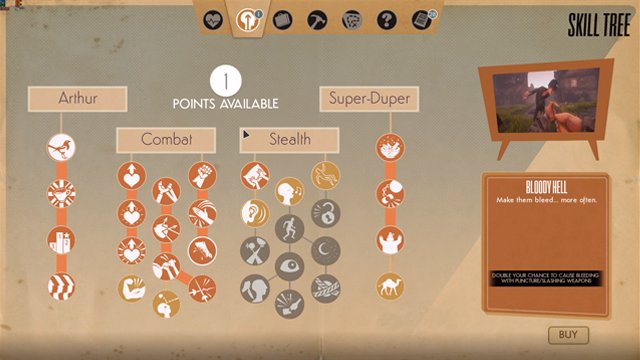
Taking out enemies mostly comes down to close-quarters melee combat. If you can sneak up on an enemy, they can be incapacitated with a quick stealth attack. If they are alerted, or when you are facing a larger enemy, you’ll be relying on fairly basic hitting, shoving, and blocking actions. Most weapons can be held to charge for a bigger strike, while others can cause bleeding and other status effects. The best weapons are created through the in-game crafting system, for which there is both a workbench and chemistry set. There are many different items that players can make using the generous amount of scrap that litters levels. However, the more devastating weaponry first requires a blueprint to be found.
I must note the Jolly Brolly here, as this item was provided with my review copy of the game. This weapon is normally a pre-order bonus, and like many other incentives of this nature, it is way too powerful and ruins the experience. I chose not to use my Jolly Brolly until a few hours in, to get a feel for how those without the weapon would perform in combat. Unsurprisingly, using the Jolly Brolly makes things a lot easier, and after crafting it into its next stage, which boasts burning and bleeding effects, it became the only weapon I needed. You see, while other weapons break after using them for a while, the Jolly Brolly lasts forever. I’d honestly recommend not touching it for the first few hours of gameplay, at least.
To help break up the monotony of spamming melee attacks, players can use various lethal and non-lethal equipment to help deal with foes. My go-tos were the Banger, which is a very effective grenade, and the Tranquilizer Dart, which can be thrown with precision. Sally has a bigger arsenal of chems up her sleeve, to make up for lack of melee combat prowess. Playing as her made me appreciate these systems a lot more.
We Happy Few Review — To Sneak, or Not to Sneak
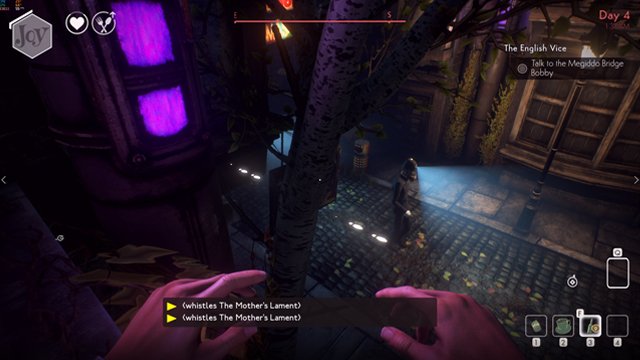
When you aren’t fighting, you’re sneaking about. As a Downer — a person who is no longer under the influence of Joy — it’s imperative that your characters act normally and don’t arouse any suspicion. Running, jumping, and wielding a weapon will alert brainwashed Wellies, so you’ll be wanting to avoid all of that. Crouching puts you into a sneak mode, with enemy footprints seen through walls. I liked this a lot, and it made the game’s many stealth sections much more tolerable.
In a 26-hour playthrough, however, there is only so much sneaking one man can take! After the first few hours, I decided to see just how chaotic things became if your character suddenly decided to sprint everywhere, alerting everything and everyone. I was surprised to find that, at least when playing as Arthur’s speedy self, I could outrun literally all enemies and dodge all traps. Once I got to where I needed to be, I could then start the next mission despite being compromised.
When enemies did manage to trap me into a corner, I found that strafing while attacking helped me land easy hits, even when the foe was attempting to block. It felt pretty cheesy, but after three hours of walking everywhere and one too many stealth encounters, I had lost time to make up for. Following that initial period where I played how the developers probably wanted me to play, I spent the remaining time sprinting everywhere and never being caught, sidestepping to topple previously terrifying enemies, and generally making a mockery of the entire population.
We Happy Few Review — Life’s a Glitch and Then You Reload
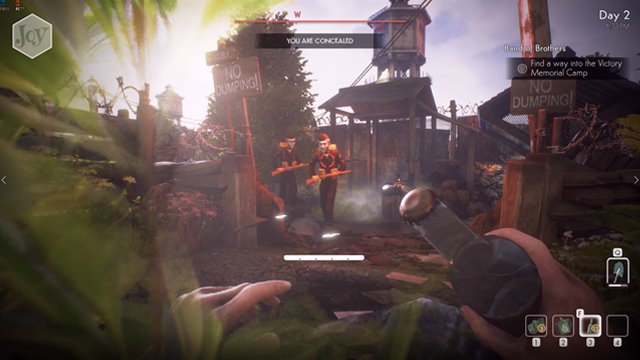
Unfortunately, We Happy Few is also besieged with technical problems. Pre-launch builds are always tricky to judge, as we live in a time where “day one patches” are becoming increasingly common. With that said, I’ve been provided with a build deemed suitable for review, and so it would be remiss of me to omit the multitude of bugs and glitches I’ve come across.
Minor issues like NPCs clipping through the floor while walking, or the screen shaking out of control during a particularly intense sequence, are perhaps negligible in the grand scheme of a lengthy game. However, I can’t ignore the times that I loaded in to find myself stuck on a bench, unable to stand up, forcing me to load an earlier save. Sometimes I spawned into an already alerted group of guards. I also came across open doors that wouldn’t let me cross the threshold. I must also mention the occasions where my character became totally invisible and invincible, allowing me to go on one hell of a killing spree.
Take a look at one such instance below:
Most frustrating of all is when the dialog just seems to stop for whatever reason with subtitles disappearing, too. One particularly annoying example of this was during the final moments of Arthur’s act. I had just made a big discovery, Arthur said one word, and then nothing followed. I had to reload my save and replay the entire section to hear what he should have said.
There’s a clear need for extra polish in the build I’m assessing, but again, it’s possible that these problems will be fixed at launch or sometime further down the line.
We Happy Few Review— Series of Unfortunate Events

We Happy Few succeeds in its presentation, with a world that is interesting to explore and interact with, at least for a little while. The story it tells is compelling, with dark themes combined with a touch of comedy, further enhanced by documents expanding on lore. And although Arthur is repugnant, Sally and Ollie both make up for him. All of their stories conclude in a satisfying enough way, though BioShock this is not. Combat is functional, aside from that broken sidestepping move, and crafting allows for creative ways of taking out stronger enemies. Stealth has some unique elements, but quickly becomes tiresome, as does behaving and conforming to walking everywhere.
For $60 I needed to see more quality, and instead became overloaded with quantity. Despite the game’s shortcomings, I am excited for the season pass, which promises to explore more characters and take a deeper dive into the world. Hopefully we’ll also be treated to a smattering of patches to add more polish to the experience. In its launch state, however, We Happy Few pleases the eyes and ears, but much like the fictional drug it features, the Joy is great… until it wears off.
-
Great visuals and style
-
Some compelling story elements
-
Many memorable characters
-
Combat is just okay
-
Stealth gets old pretty damn quickly
-
PC performance is a tad worrying
-
Too many bugs and glitches
-
$60 price tag
